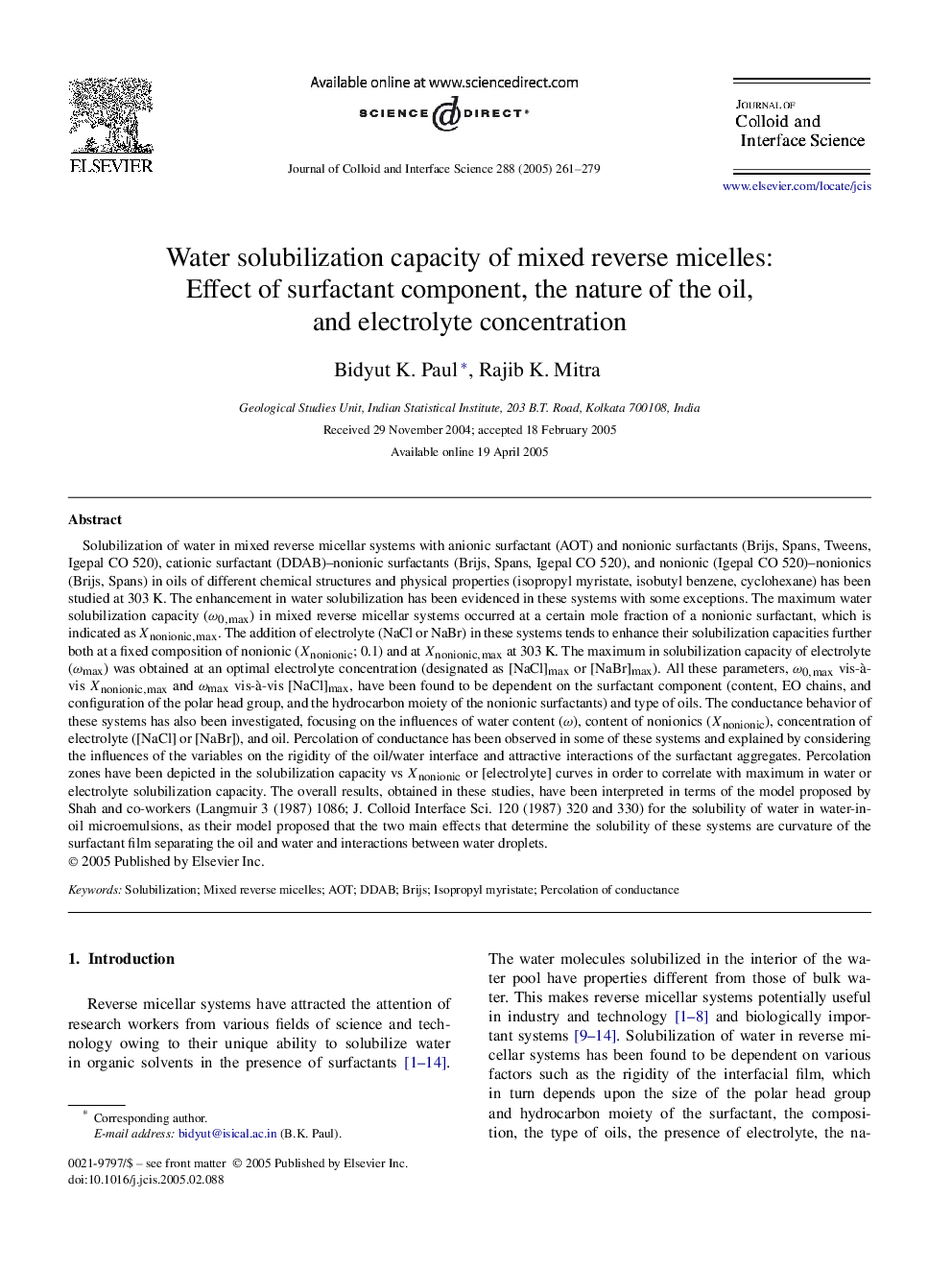| کد مقاله | کد نشریه | سال انتشار | مقاله انگلیسی | نسخه تمام متن |
|---|---|---|---|---|
| 10377881 | 880745 | 2005 | 19 صفحه PDF | دانلود رایگان |
عنوان انگلیسی مقاله ISI
Water solubilization capacity of mixed reverse micelles: Effect of surfactant component, the nature of the oil, and electrolyte concentration
دانلود مقاله + سفارش ترجمه
دانلود مقاله ISI انگلیسی
رایگان برای ایرانیان
کلمات کلیدی
موضوعات مرتبط
مهندسی و علوم پایه
مهندسی شیمی
شیمی کلوئیدی و سطحی
پیش نمایش صفحه اول مقاله

چکیده انگلیسی
Solubilization of water in mixed reverse micellar systems with anionic surfactant (AOT) and nonionic surfactants (Brijs, Spans, Tweens, Igepal CO 520), cationic surfactant (DDAB)-nonionic surfactants (Brijs, Spans, Igepal CO 520), and nonionic (Igepal CO 520)-nonionics (Brijs, Spans) in oils of different chemical structures and physical properties (isopropyl myristate, isobutyl benzene, cyclohexane) has been studied at 303 K. The enhancement in water solubilization has been evidenced in these systems with some exceptions. The maximum water solubilization capacity (Ï0,max) in mixed reverse micellar systems occurred at a certain mole fraction of a nonionic surfactant, which is indicated as Xnonionic,max. The addition of electrolyte (NaCl or NaBr) in these systems tends to enhance their solubilization capacities further both at a fixed composition of nonionic (Xnonionic; 0.1) and at Xnonionic,max at 303 K. The maximum in solubilization capacity of electrolyte (Ïmax) was obtained at an optimal electrolyte concentration (designated as [NaCl]max or [NaBr]max). All these parameters, Ï0,max vis-Ã -vis Xnonionic,max and Ïmax vis-Ã -vis [NaCl]max, have been found to be dependent on the surfactant component (content, EO chains, and configuration of the polar head group, and the hydrocarbon moiety of the nonionic surfactants) and type of oils. The conductance behavior of these systems has also been investigated, focusing on the influences of water content (Ï), content of nonionics (Xnonionic), concentration of electrolyte ([NaCl] or [NaBr]), and oil. Percolation of conductance has been observed in some of these systems and explained by considering the influences of the variables on the rigidity of the oil/water interface and attractive interactions of the surfactant aggregates. Percolation zones have been depicted in the solubilization capacity vs Xnonionic or [electrolyte] curves in order to correlate with maximum in water or electrolyte solubilization capacity. The overall results, obtained in these studies, have been interpreted in terms of the model proposed by Shah and co-workers (Langmuir 3 (1987) 1086; J. Colloid Interface Sci. 120 (1987) 320 and 330) for the solubility of water in water-in-oil microemulsions, as their model proposed that the two main effects that determine the solubility of these systems are curvature of the surfactant film separating the oil and water and interactions between water droplets.
ناشر
Database: Elsevier - ScienceDirect (ساینس دایرکت)
Journal: Journal of Colloid and Interface Science - Volume 288, Issue 1, 1 August 2005, Pages 261-279
Journal: Journal of Colloid and Interface Science - Volume 288, Issue 1, 1 August 2005, Pages 261-279
نویسندگان
Bidyut K. Paul, Rajib K. Mitra,